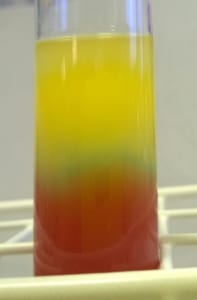 This is a simple demonstration (or experiment) that can be used to illustrate the relationship of conjugated systems and colour.
This is a simple demonstration (or experiment) that can be used to illustrate the relationship of conjugated systems and colour.
The red colour of tomatoes is mainly due to the carotenoid, lycopene, which is a tetraterpene, having 8 isoprene units. (Though there is also some β-carotene, another, similar tetraterpene)
When saturated bromine water is gently stirred into tomato juice colour changes occur, and the concentration gradient created causes a rainbow effect. The reaction takes place in less than a minute and the colours persist for hours, making this demonstration fairly dramatic yet safe and easy to do.
It is the length of the conjugated system in lycopene that causes absorption in the blue region of the visible spectrum and gives them the characteristic red colour. If a double bond is attacked and removed by an agent like bromine, the length of conjugation shortens, the wavelength becomes smaller, and the absorption shifts to the ultraviolet region of the spectrum causing the compound to become colourless.



